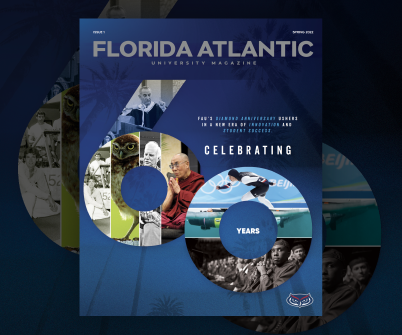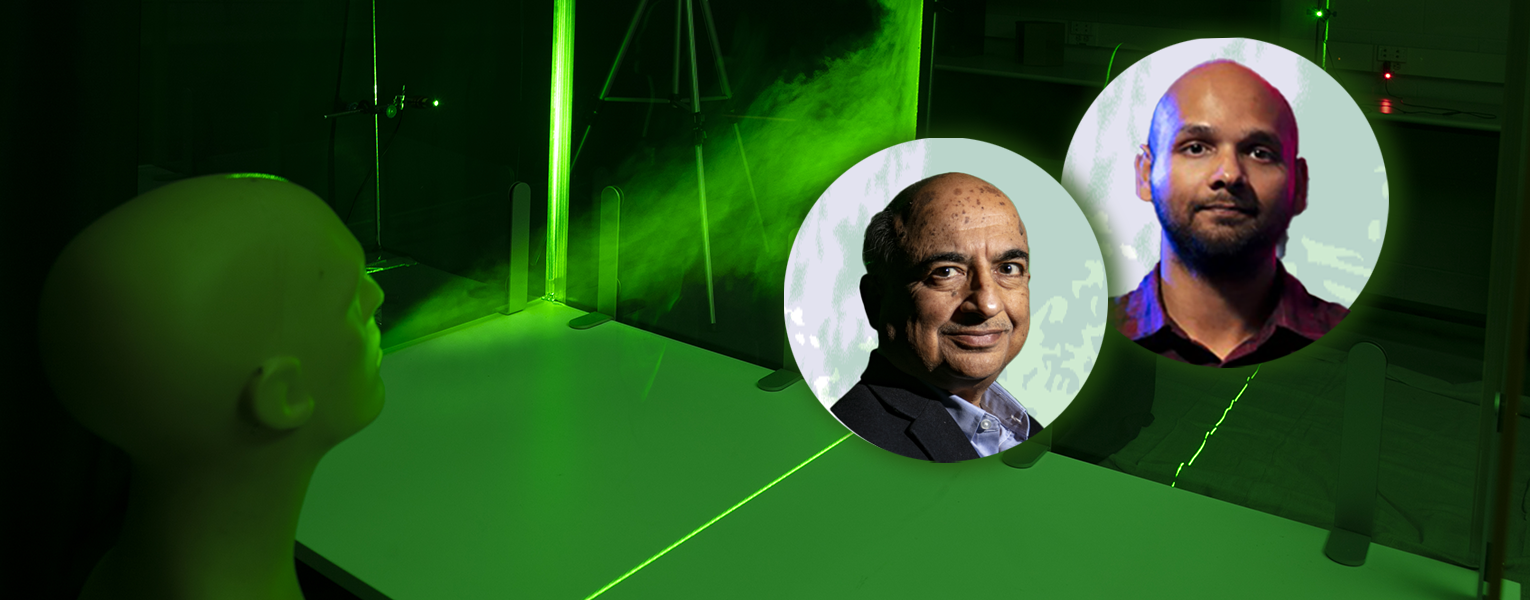 "Shielding Society" comes from the Florida Atlantic magazine. View stories like this and more at www.fau.edu/newsdesk/magazine.
"Shielding Society" comes from the Florida Atlantic magazine. View stories like this and more at www.fau.edu/newsdesk/magazine.
7/24/2022
Shielding Society
Researchers Demonstrate if Plexiglass Protects Against COVID-19 on CNN’s ‘Anderson Cooper 360°’
By Gisele Galoustian
With a grant from the U.S. Centers for Disease Control and Prevention, FAU engineering professors are testing and quantifying how effective various protective measures are in preventing the spread of COVID-19 and its variants in the workplace. They are specifically focused on mitigating airborne viral transmission of aerosolized droplets.
Their research, which has received national and international media attention, has demonstrated how aerosolized droplets projected by a cough from a mannequin in the lab can travel more than 12 feet from the source. They have also illuminated how airborne transmission of virus-carrying saliva droplets from infectious coughs, sneezes and exhalations range in size, with the larger droplets generally falling to the ground and much smaller droplets remaining suspended in the air for a significant amount of time.
In their lab at FAU’s SeaTech campus in Dania Beach, Manhar Dhanak, Ph.D., chair and professor, and Siddhartha Verma, Ph.D., assistant professor, Department of Ocean and Mechanical Engineering, College of Engineering and Computer Science, put their research to the test for CNN’s Randi Kaye on “Anderson Cooper 360°.” The objective was to demonstrate if plexiglass shields commonly used as barriers in retail, airports and offices ensure a safer workplace environment.
For the CNN experiment, Dhanak and Verma used a mixture of distilled water and glycerin to generate a synthetic fog to simulate a cough mechanically emulated from the mannequin’s mouth. The process they’ve developed and published in the journal Physics of Fluids, generates puffs of air containing aerosolized droplets representing smaller droplets typically present in respiratory exhalations. To visualize the particles from the exhaled air in the mannequin and film the cough jet, the researchers used LED and laser lights. The visualization highlights the structure and motion of the jets and provides the distances over which the jets extend from the source.
Their CNN experiment showed that a single plexiglass shield captured most of the particles from a direct hit, however, the smaller aerosolized particles, which are of most concern, still escaped over the top, bottom and sides of the barrier. Even with the screen, lighter aerosolized particles accumulated in the air and lingered for about seven or eight minutes.
“The plexiglass doesn’t stop the particles 100 percent, but it does reduce the droplet concentration by about 80 percent so that the viral load is much lower and the cough stream may not go as far because of the barrier,” Dhanak said. “While these shields can help protect you, it’s also important to point out that too many of them in one room can block the airflow and place people at risk. Poor ventilation could result in a backdraft effect.”
The researchers also tested a three-sided plexiglass shield at a desk workstation in their state-of-the-art lab. Results revealed that it protected against the initial force from the simulated cough. However, the aerosolized droplets or “virus” circulated within the workstation placing those behind the desk at risk from the droplets moving in a backward motion.
To provide an extra measure of protection, Dhanak and Verma also showed Kaye how adding a face mask along with the plexiglass shield can help. It turns out that quality is key. With the cloth mask, most of the aerosolized particles got through. However, with an N-95 mask, all the droplets were contained except from a small gap at the bridge of the nose. The researchers say that this upward stream is much more desirable than one with a forward motion.
Dhanak and Verma are building on their prior research using flow visualization for coughs, sneezes, social distancing and the efficacy of face masks and face shields, which has been featured by “TODAY,” “Good Morning America,” CBS National News, NBC National News, CNN, CNN International, Telemundo, “Dr. Oz,” The New York Times, People, “Inside Edition,” NPR, United Press International, among others. Media generated from their research on face shields and face masks has resulted in more than 445,000 views of their journal article in Physics of Fluids, placing it in the top 5 percent of all research outputs by Altmetric, used as an impact factor for scholarly and scientific publishing.
The researchers continue to test and quantify the effectiveness of various protective measures under new American Society for Testing Materials standards and best safety practices in the workplace. In addition to evaluating face masks and other personal protection equipment and physical safety barriers, Dhanak and Verma are investigating interior designs of spaces, air filters, humidifiers, safe seating arrangements in a classroom setting and queuing at checkouts, as well as other measures.
“Our research on preventive measures for mitigating airborne transmission of viral infections has important implications not only for COVID-19 but for other potential emerging infectious diseases that could impact our society locally as well as globally,” Dhanak said.
If you would like more information, please contact us at dorcommunications@fau.edu.
